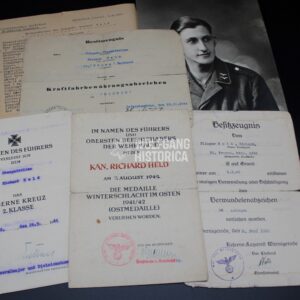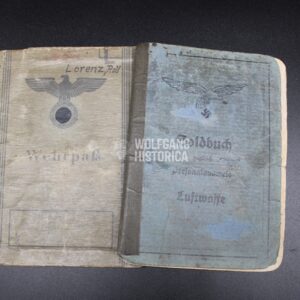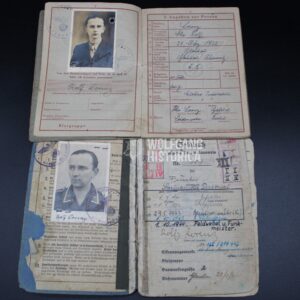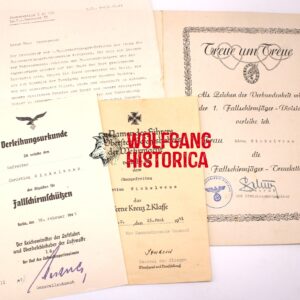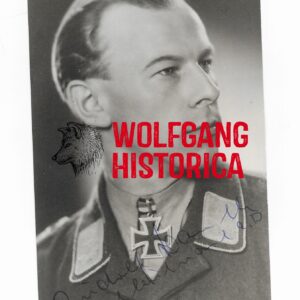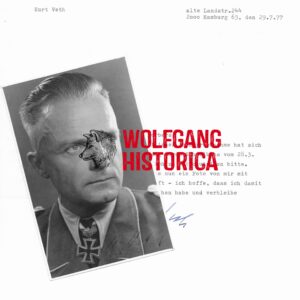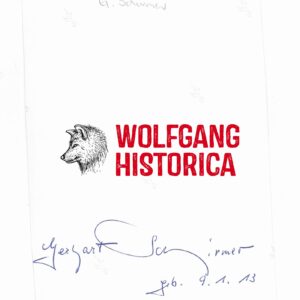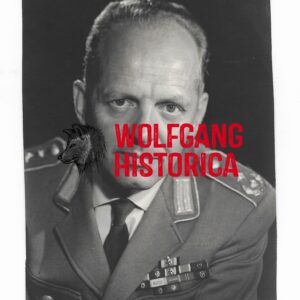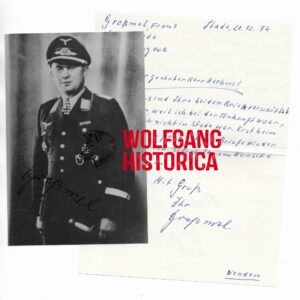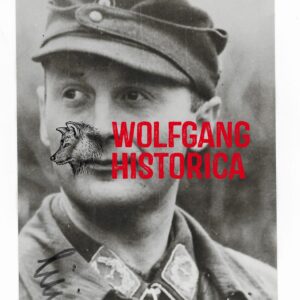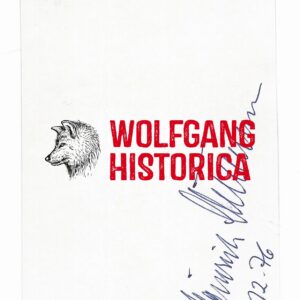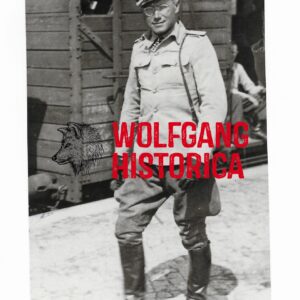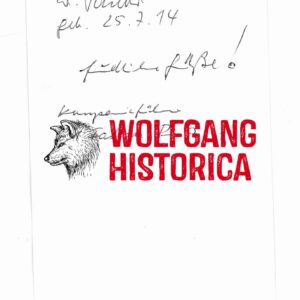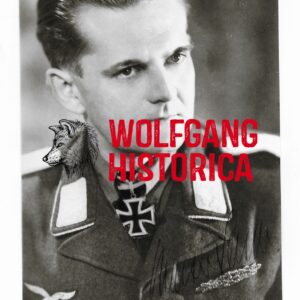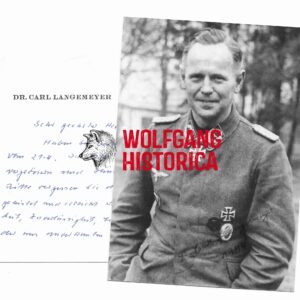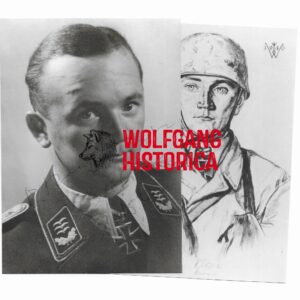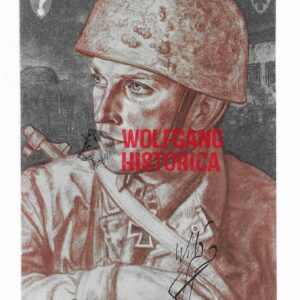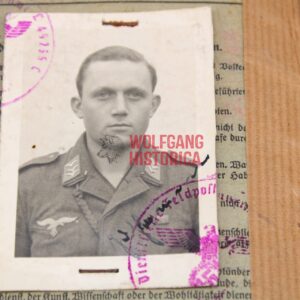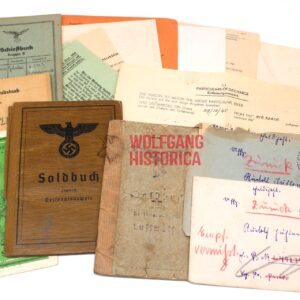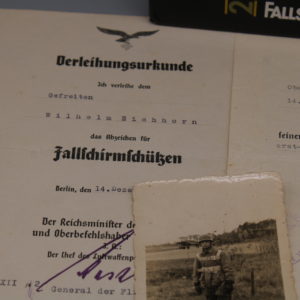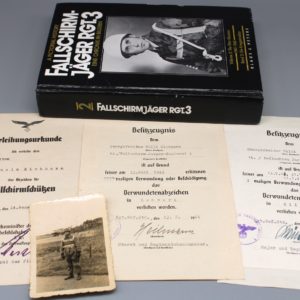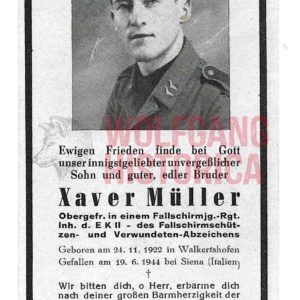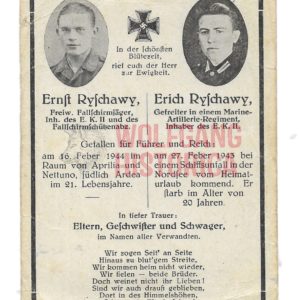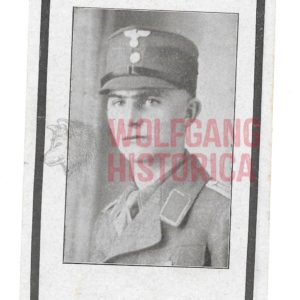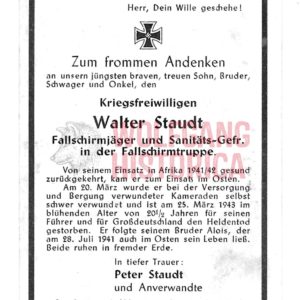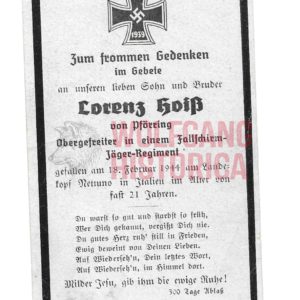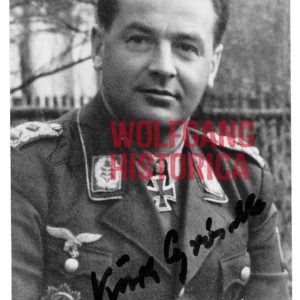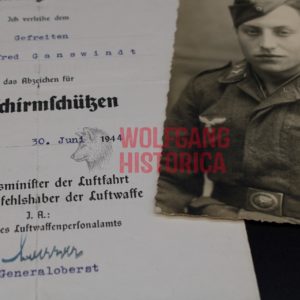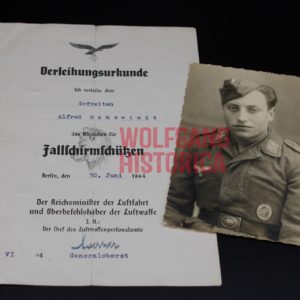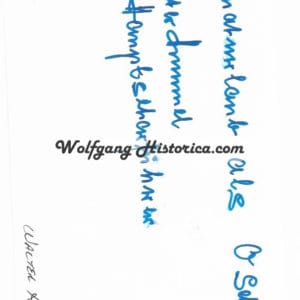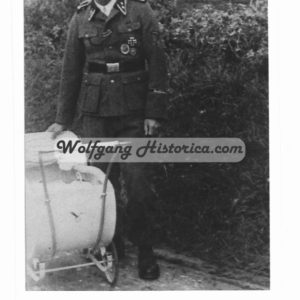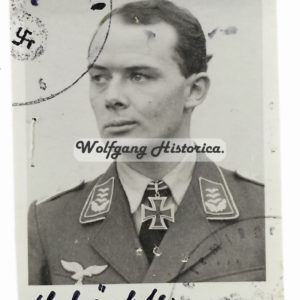Award Doc Grouping of Fallschirmjäger – Flieger-Transport-Batterie & Fallschirmjäger-Sturm-Regiment (Italy 1944-45!)
€0,01- Award document for the Winterschlacht im Osten 1941/42 (Winter War Medal). Beautiful!
- Award document for the Eisernes Kreuz 2. Klasse (Iron Cross 2nd Class). Signed by Heinrich Trettner (RK+EL)!
- Award document for the Verwundetenabzeichen in Schwarz (Wound Badge in Black).
- Award document for the Kraftfahrbewährungsabzeichen in Bronze (Driver's Profiency Badge in Bronze).
- Paper from Fallschirmjägerschule Wittstock regarding the estate of likely his brother?
- Large Photo
Wehrpass & Soldbuch of Feldwebel in Fallschirmjäger-Regiment 9 (KVK2, EKA & VWA during Normandy!)
€0,01TOP Death Card of Fallschirmjäger – KIA in Ardennes (!) (Camo & Helmet!)
€0,01Fallschirmjäger-Treuekette, Fallschirmschützen-Abzeichen & EK2 Set of KIA Paratrooper
€0,01- The rare and attractive "Fallschirmjäger-Treuekette" certificate which was awarded to his wife. Complete with the - most of the time - missing fold-out page which bears the blind embossed seal of the Fallschirmschützenabzeichen. Certificate was signed by Oberst Karl-Lothar Schulz (RK+EL+SW!)
- Award document for the Eisernes Kreuz 2. Klasse (Iron Cross 2nd Class) for his service on June 15, 1941, which was signed by General der Flieger Kurt Student (RK+EL). This was most likely for actions during the Battle of Kreta!
- Award document for the Fallschirmschützenabzeichen (Paratrooper Badge) for completing his jump training on February 18, 1941.
- Letter of the Kompanieführer to Winkelvoss' his wife regarding the awarding of the Fallschirmjäger-Treuekette to her in memory of her fallen husband.
Erich Pietzonka – Fallschirmjäger-Regiment 7 (Eichenlaub)
€65,00Original Postwar Signature on a Postwar Photo of Erich Pietzonka. Oberst Erich Pietzonka (04.10.1906 † 18.12.1989) earned the Ritterkreuz des Eisernen Kreuzes on September 5, 1944 as Oberstleutnant und Kommandeur and the Eichenlaub on September 16, 1944 as Oberst und Kommandeur of Fallschirmjäger-Regiment 7 of the 2. Fallschirmjäger-Division.
Provenance: This signature comes from one of the largest postwar signature collection I’ve ever commissioned. This collection was started by a Waffen-SS Veteran, Werner H., in the 1950’s until he passed away.
Rudolf Donth – Fallschirmjäger-Regiment 4 (1.FJ-Div.)
€25,00Original Postwar Signature on a Postwar Photo of Rudolf Donth. Feldwebel Rudolf Donth (16.02.1920 † 19.06.2001) earned the Deutsches Kreuz in Gold on June 14, 1944 as Oberjäger in the 6. Kompanie/ Fallschirmjäger-Regiment 4 and the Ritterkreuz on January 14, 1945 as Feldwebel und Führer of the 6. Kompanie/ Fallschirmjäger-Regiment 4 of the 1. Fallschirmjäger-Division.
Provenance: This signature comes from one of the largest postwar signature collection I’ve ever commissioned. This collection was started by a Waffen-SS Veteran, Werner H., in the 1950’s until he passed away.
Kurt Veth – Fallschirmjäger-Regiment 3 (Monte Cassino) (Eichenlaub)
€0,01Original Postwar Signature on a Postwar Paper Photo & Letter of Kurt Veth. Major Kurt Veth (01.06.1907 † 27.12.1994) earned the Ritterkreuz des Eisernen Kreuzes on September 30, 1944 as Hauptmann with the II. Bataillon/ Fallschirmjäger-Regiment 3 and the Eichenlaub on April 30, 1945 as Major with the II. Bataillon/ Fallschirmjäger-Regiment 3 of the 3. Fallschirmjäger-Division.
Provenance: This signature comes from one of the largest postwar signature collection I’ve ever commissioned. This collection was started by a Waffen-SS Veteran, Werner H., in the 1950’s until he passed away.
Gerhart Schirmer – Fallschirmjäger-Regiment 2 & 26 (Eichenlaub)
€0,01Original Postwar Signature on a Postwar Photo of Gerhart Schirmer. Oberstleutnant Gerhart Schirmer (09.01.1913 † 05.09.2004) earned the Deutsches Kreuz in Gold on June 25, 1943 with III. Bataillon/ Jäger-Regiment "Hermann Göring", the Ritterkreuz on June 14, 1941 as Hauptmann und Führer of the II. Bataillon/ Fallschirmjäger-Regiment 2 and the Eichenlaub on November 18, 1944 as Oberstleutnant und Kommandeur of Fallschirmjäger-Regiment 26. Good Condition.
Provenance: This signature comes from one of the largest postwar signature collection I’ve ever commissioned. This collection was started by a Waffen-SS Veteran, Werner H., in the 1950’s until he passed away.
Franz Graßmel – Fallschirmjäger-Regiment 4
€85,00Original Scarce Postwar Signature on a Postwar Photo plus Letter of Franz Graßmel. Oberstleutnant Franz Graßmel (08.06.1906 † 30.06.1985) earned the Ritterkreuz des Eisernen Kreuzes on April 8, 1944 as Major und Kommandeur of the III. Bataillon/ Fallschirmjäger-Regiment 4 of the 1. Fallschirmjäger-Division and the Eichenlaub on May 8, 1945 as Major und Kommandeur of the Fallschirmjäger-Regiment 20 of the 7. Fallschirmjäger-Division. Eichenlaub may not be official.
Provenance: This signature comes from one of the largest postwar signature collection I’ve ever commissioned. This collection was started by a Waffen-SS Veteran, Werner H., in the 1950’s until he passed away.
Walter Paul Liebing – Fallschirmjäger-Regiment 23
€0,01Original Scarce Postwar Signature on a Postwar Photo of Walter Paul Liebing. Oberstleutnant Walter Paul Liebing (12.08.1912 † 18.10.1998) earned the Ritterkreuz des Eisernen Kreuzes on February 2, 1945 as Major und Kommandeur of the Fallschirmjäger-Regiment 23 of the 2. Fallschirmjäger-Division.
Provenance: This signature comes from one of the largest postwar signature collection I’ve ever commissioned. This collection was started by a Waffen-SS Veteran, Werner H., in the 1950’s until he passed away.
Dr.med. Heinrich Neumann – Luftlande-Sturm-Regiment 1 (Kreta)
€0,01Original Scarce Postwar Signature on a Postwar Photo of Dr.med. Heinrich Neumann. Oberstabsarzt Dr.med. Heinrich Neumann (17.02.1908 † 19.05.2005) earned the Ritterkreuz des Eisernen Kreuzes on August 21, 1941 as Oberstabsarzt und Regimentsarzt of Luftlande-Sturm-Regiment 1.
Provenance: This signature comes from one of the largest postwar signature collection I’ve ever commissioned. This collection was started by a Waffen-SS Veteran, Werner H., in the 1950’s until he passed away.
Walter Sander – Fallschirm-Pionier-Bataillon 5 (Battle of the Bulge)
€0,01Original Scarce Postwar Signature on a Postwar Photo of Walter Sander. Oberleutnant Walter Sander (25.07.1914 † 28.04.1981) earned the Ritterkreuz des Eisernen Kreuzes on February 28, 1945 as Leutnant und Führer of 1. Kompanie/ Fallschirm-Pionier-Bataillon 5 of the 5. Fallschirmjäger-Division.
Provenance: This signature comes from one of the largest postwar signature collection I’ve ever commissioned. This collection was started by a Waffen-SS Veteran, Werner H., in the 1950’s until he passed away.
Dr. Carl Neumayer – Fallschirm-Sanitäts-Lehr-Abteilung Nancy
€85,00Original Scarce Postwar Signature on a Postwar Photo plus Card of Dr. Carl Langemayer. Oberstabsarzt Dr. Carl Neumayer (06.08.1907 † 25.07.1982) earned the Ritterkreuz des Eisernen Kreuzes on November 18, 1940 as Stabsarzt und Kommandeur of Fallschirm-Sanitäts-Lehr-Abteilung Nancy.
Provenance: This signature comes from one of the largest postwar signature collection I’ve ever commissioned. This collection was started by a Waffen-SS Veteran, Werner H., in the 1950’s until he passed away.
Dr.med. Rolf Jäger – Fallschirm-Sturm-Abteilung “Koch” (Vroenhoven)
€75,00Original Scarce Postwar Signature on a Postwar Photo of Dr.med. Rolf Jäger. Oberstabsarzt Dr.med. Rolf Jäger (01.11.1912 † 06.01.1984) earned the Ritterkreuz des Eisernen Kreuzes on May 15, 1940 as Oberarzt und Truppenarzt of Fallschirm-Sturm-Abteilung Koch.
Provenance: This signature comes from one of the largest postwar signature collection I’ve ever commissioned. This collection was started by a Waffen-SS Veteran, Werner H., in the 1950’s until he passed away.
Rudolf Witzig – Sturmgruppe Granit (Eben-Emael) & FJ-Pio.-Rgt. 21 (Eichenlaub)
€65,00Original Postwar Signature on a Postwar Photo plus Letter of Rudolf Witzig. Major Rudolf Witzig (14.08.1916 † 03.10.2001) earned the Ritterkreuz on May 10, 1940 as Oberleutnant with the Sturmgruppe Granat of the Fallschirm-Sturm-Abteilung “Koch” and the Eichenlaub on August 8, 1944 as Major und Kommandeur of the I. Bataillon/ Fallschirm-Pionier-Regiment 21. Good condition.
Oberleutnant Rudolf Witzig, commander of Sturmgruppe Granit. The Sturmgrupe Granit (Granite) was the assault group that famously captured the Belgian Eben-Emael fort on 10 May 1940 led by Oberleutnant Rudolf Witzig. It was 86 men strong and was carried in 11 gliders. Glider 11: Oberleutnant Rudolf Witzig, Oberjäger Fritz Schwarz, Unteroffizier Karl Pilz (Pilot), Otto Braun (WIA), Uwe Johnsen, Hans-Peter Krenz, Fritz Kruck (KIA)Provenance: This signature comes from one of the largest postwar signature collection I’ve ever commissioned. This collection was started by a Waffen-SS Veteran, Werner H., in the 1950’s until he passed away.
Rudolf Witzig – Sturmgruppe Granit (Eben-Emael) & FJ-Pio.-Rgt. 21 (Eichenlaub) (Wartime Signed)
€0,01Provenance: This signature comes from one of the largest postwar signature collection I've ever commissioned. This collection was started by a Waffen-SS Veteran, Werner H., in the 1950's until he passed away.
Friedrich August Freiherr von der Heydte – Carentan & Operation Stösser
€0,01Death Card: KIA January 31, 1945 – Westfront (Fallschirmjäger)
€35,00- The death card may have a different color than the scan shows. The scan seem to make the death cards more white than they are.
- The "Sterbekartei" (Card from Ancestry that shows the unit, fate..) provided here is only a digital copy! Not part of the original sale.
Soldbuch Fallschirmjäger-Rgt. 9 (3. FJ.DIV) NORMANDY! POW: Kessel of Mons (4x Awards)
€0,013x Award Docs: Fallschirmjäger-Regiment 3 (Sicily, Italy)
€600,00- Award document for the Fallschirmschützenabzeichen (Paratrooper Badge) for completing his jump training in December 1942
- Award document for the Verwundetenabzeichen in Schwarz (Wound Badge in Black), signed by Oberst Ludwig Heilmann (KC+El+SW !)
- Award document for the Verwundetenabzeichen in Silber (Wound Badge in Silver), signed by unknown officer (likely Btl.Cdr. acting as Rgt.Cdr.). Document was shortened and pasted on a A5 paper.
- Photograph
- Book

